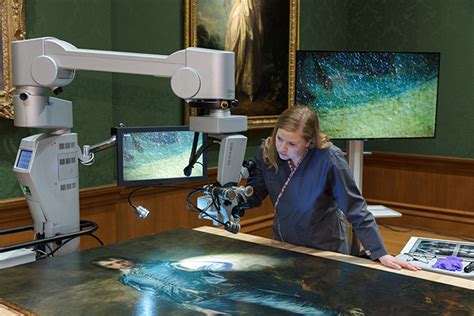Preserving Timeless Artifacts: Becoming a Museum Conservator
As museum conservators, we play a crucial role in preserving the cultural heritage and historical significance of artifacts for future generations. In this blog post, we will delve into the world of museum conservation and explore the various aspects that make up this fascinating and highly specialized field.
From understanding the definition of a museum conservator to the skills and educational paths required to become one, we will cover it all. We will also discuss the importance of conservation ethics and standards, and how environmental factors can impact the preservation of valuable artifacts. Furthermore, we will explore the various conservation techniques for delicate materials, and the challenges that come with digital preservation.
Additionally, we will shed light on the collaborative efforts between conservators and researchers, and the role of conservation in museum exhibitions. Lastly, we will touch upon the promising career prospects and opportunities that await aspiring conservators. Join us as we embark on this journey into the world of museum conservation!
Table of Contents
What is a museum conservator?
A museum conservator is a professional who is responsible for the preservation and restoration of cultural artifacts and works of art. Their main goal is to ensure that these items are safeguarded for future generations to enjoy and study.
Conservators use a combination of scientific knowledge, artistic skill, and technical expertise to carefully examine, clean, repair, and protect items in museum collections. They work with a wide range of materials, including paintings, textiles, ceramics, and archaeological objects.
It is crucial for museum conservators to have a deep understanding of the unique properties of each material and the specific conservation issues that may arise. They must also stay up-to-date with the latest research and technologies in the field in order to effectively preserve and care for the items in their care.
In addition to their hands-on work, conservators often collaborate with other museum professionals, such as curators, educators, and researchers, to develop conservation strategies and ensure that the artifacts are properly displayed and stored.
The skills required to become a conservator
Becoming a successful conservator requires a unique set of skills that go beyond just a passion for art and history. Attention to detail is one of the most crucial skills that a conservator must possess. This involves being able to closely examine and analyze artifacts to understand their condition and the best methods for their preservation.
Another important skill is a deep understanding of chemistry and material science. Conservators must have the knowledge and expertise to analyze the composition of artifacts and understand how different materials will react to various preservation techniques.
Additionally, strong research skills are essential for conservators. They must be able to investigate the historical and cultural context of the artifacts they work on, as well as stay updated on the latest conservation methods and technologies.
Finally, strong communication skills are critical, as conservators often work closely with museum staff, researchers, and other experts. The ability to effectively convey their findings and recommendations is essential for the successful preservation of cultural heritage.
Educational paths for aspiring conservators
Aspiring conservators can pursue several educational paths to acquire the necessary knowledge and skills for a successful career in conservation. One popular route is to obtain a bachelor’s degree in a related field such as art history, archaeology, or studio art. This provides a solid foundation in the historical and artistic context of artifacts, as well as practical experience in handling and documenting cultural objects.
Another option is to pursue a master’s degree in conservation, which offers specialized training in the technical aspects of preserving and restoring cultural heritage. These programs typically include coursework in chemistry, materials science, and conservation techniques, along with hands-on lab experience working with different types of artifacts.
For those interested in a more research-focused approach, a doctoral degree in conservation science or a related field can provide the advanced knowledge and expertise needed to contribute to the development of new conservation methods and technologies.
Additionally, aspiring conservators can benefit from internships or apprenticeships at museums, conservation labs, or heritage institutions, where they can gain valuable practical skills and professional connections in the field. These hands-on experiences can complement formal education and provide a well-rounded foundation for a successful career in conservation.
Importance of conservation ethics and standards
Conservation ethics and standards are crucial in the preservation of cultural heritage for future generations. Conservation ethics provide a framework for professionals to make decisions that will ensure the longevity and integrity of artifacts and artworks. These ethical guidelines help conservators prioritize the well-being of the objects in their care over personal or institutional interests.
Additionally, conservation standards outline best practices for the treatment and handling of cultural materials. Adhering to these standards ensures that artifacts are treated with the utmost care and respect, minimizing the risk of damage or deterioration during conservation processes.
By upholding conservation ethics and standards, conservators can contribute to the overall integrity of museum collections and historic sites. This commitment to ethical practices not only preserves the authenticity of cultural heritage but also fosters trust and credibility within the conservation field.
In conclusion, the importance of conservation ethics and standards cannot be overstated. They serve as the foundation for responsible and sustainable conservation practices, ensuring that the cultural treasures of our past are safeguarded for future generations to appreciate and learn from.
The impact of environmental factors on artifacts
Environmental factors can have a significant impact on the preservation of artifacts and cultural heritage. Humidity, temperature fluctuations, pollution, and light exposure are some of the key environmental factors that can cause irreparable damage to artifacts if not properly managed.
High humidity levels can lead to mold growth, corrosion of metals, and deterioration of organic materials such as textiles and wood. On the other hand, low humidity can cause shrinkage and cracking of materials. Temperature fluctuations can also cause physical damage to artifacts, especially those made of multiple materials or those with layers of paint or varnish.
Pollution from industrial emissions, vehicle exhaust, and other sources can deposit harmful particles on artifacts, leading to discoloration, corrosion, and weakening of materials. Additionally, exposure to light, especially ultraviolet radiation, can cause fading, yellowing, and embrittlement of organic materials.
Conservators must therefore take into account these environmental factors when devising strategies for the preservation and long-term care of artifacts. Proper environmental monitoring, control, and preventive conservation measures are essential to mitigate the impact of these factors and ensure the longevity of cultural heritage.
Conservation techniques for delicate materials
When it comes to preserving delicate materials, such as textiles, paper, or organic artifacts, conservation techniques play a crucial role in ensuring their longevity. One of the primary challenges in conserving delicate materials is finding methods that are effective in stabilizing and protecting the artifacts without causing further damage. This requires a deep understanding of the materials themselves, as well as the specific conservation techniques that can be used to mitigate deterioration.
One of the most commonly used conservation techniques for delicate materials is preventive conservation, which focuses on controlling the environment in which the artifacts are stored or displayed. This includes regulating temperature and humidity levels to prevent mold growth, as well as minimizing exposure to light and pollutants that can cause discoloration or degradation.
In addition to preventive conservation, conservators also utilize a range of specialized treatments to address existing damage or deterioration. For example, when dealing with fragile textiles, conservation techniques may involve surface cleaning, stain removal, and reinforcement of weakened fibers to prevent further fraying.
Another important aspect of conservation techniques for delicate materials is the use of archival-quality materials for housing and storage. This helps to create a stable microenvironment that minimizes the risk of damage from external factors, such as fluctuations in temperature and humidity.
Digital preservation and its challenges
Digital preservation refers to the process of ensuring that digital information remains accessible and usable in the long term. In today’s digital age, the challenge of preserving digital content has become increasingly complex due to rapid technological advancements and the sheer volume of data being generated.
One of the major challenges in digital preservation is the constant evolution of file formats and software. As new technologies emerge, older file formats and software become obsolete, making it difficult to access and retrieve digital information stored in these formats. This requires digital preservationists to continuously monitor and update their systems to ensure the continued accessibility of digital content.
Another challenge is the vulnerability of digital content to cyber threats and data loss. With the increasing frequency and sophistication of cyber-attacks, digital preservationists must implement robust security measures to protect digital assets from unauthorized access, data breaches, and other cyber threats. Additionally, the risk of data loss due to hardware failure, system crashes, or natural disasters poses a significant challenge to digital preservation efforts.
Furthermore, the rapid pace of technological change means that digital preservationists must constantly adapt to new tools and strategies for preserving digital content. This requires ongoing training and professional development to stay current with the latest trends and best practices in digital preservation.
Collaborations between conservators and researchers
Collaborations between conservators and researchers are essential for the preservation and study of cultural artifacts. Both parties bring unique expertise to the table, with conservators specializing in the physical care and treatment of objects, and researchers delving into the historical and scientific context of the artifacts. These collaborations often involve joint projects, where conservators and researchers work closely together to analyze, document, and preserve cultural materials.
One of the main goals of these collaborations is to gain a deeper understanding of the materials and techniques used in creating the artifacts. Conservators provide valuable insights into the physical condition of the objects, while researchers contribute historical and scientific data. By combining their expertise, they can develop comprehensive conservation plans that take into account both the material aspects and the cultural significance of the artifacts.
Collaborations between conservators and researchers also play a crucial role in advancing conservation science. Through these partnerships, new techniques and methodologies are developed to better study and preserve cultural materials. Additionally, the exchange of knowledge and ideas between the two parties leads to innovative approaches to conservation, improving the overall care and treatment of artifacts.
Furthermore, these collaborations often result in joint publications and presentations, sharing the findings and outcomes of their projects with the broader academic and museum community. This not only contributes to the advancement of conservation research but also raises public awareness about the importance of preserving cultural heritage.
Role of conservation in museum exhibitions
Conservation plays a crucial role in museum exhibitions, ensuring that artifacts and artworks are preserved and displayed in their best possible condition. The conservators are responsible for examining, documenting, and treating objects to ensure their long-term stability and prevent further deterioration. They work closely with curators and exhibition designers to determine the best display methods that will protect the objects while also effectively communicating the historical and cultural significance to the audience.
Furthermore, conservation in museum exhibitions also involves making important decisions regarding the use of lighting, temperature, and humidity to create a safe environment for the artifacts. Conservators must consider the potential risks of display, such as exposure to light and handling by visitors, and implement measures to mitigate these risks without compromising the overall visitor experience. By collaborating with other museum professionals, conservators contribute to the creation of engaging and educational exhibitions that are both visually compelling and ethically responsible.
Conservation in museum exhibitions also extends to the installation and dismantling of the displays. The conservators are involved in the careful handling and transport of the objects, ensuring that they are securely mounted and positioned to prevent any potential accidents or damage during the exhibition period. Additionally, they oversee the condition reporting before and after the exhibition, documenting any changes or damages that may have occurred while the objects were on display.
In conclusion, the role of conservation in museum exhibitions is multifaceted and essential to the overall success of the presentation. It upholds the integrity of the artifacts, safeguards them from harm, and contributes to the educational experience of the audience, thereby preserving our cultural heritage for future generations to appreciate.
Career prospects and opportunities in conservation
Conservation is a field that offers a wide range of career prospects and opportunities for those with a passion for preserving cultural heritage and artifacts. With the increasing demand for conservators in museums, galleries, and cultural institutions, there are numerous paths that individuals can take to establish a successful career in conservation.
One of the most common career prospects in conservation is working as a museum conservator. Museum conservators are responsible for the preservation and restoration of cultural artifacts, ensuring that they are properly maintained for future generations. This role offers the opportunity to work closely with historical and artistic objects, providing a sense of fulfillment and contribution to the preservation of human history.
Another career opportunity in conservation is in the field of digital preservation. As technology continues to play a significant role in the preservation of cultural heritage, there is a growing demand for professionals who specialize in digital conservation. This field offers opportunities to work with cutting-edge technology and develop innovative strategies for safeguarding digital collections.
Additionally, conservation also offers career prospects in research and academia. Many conservators pursue advanced degrees and research positions, contributing to the development of conservation techniques and best practices. Academic roles also provide the opportunity to share knowledge and mentor the next generation of conservators, making a lasting impact on the field.





